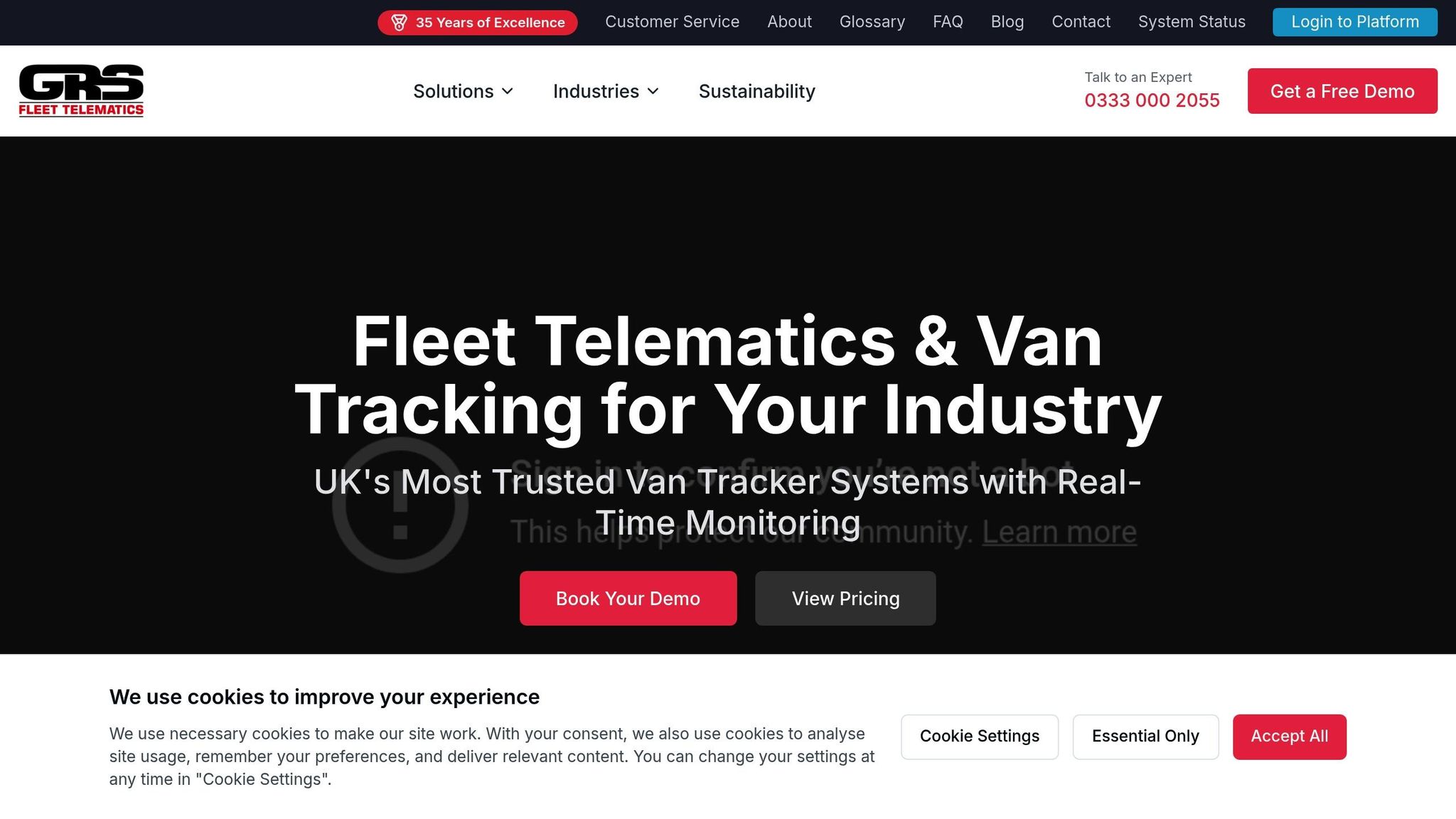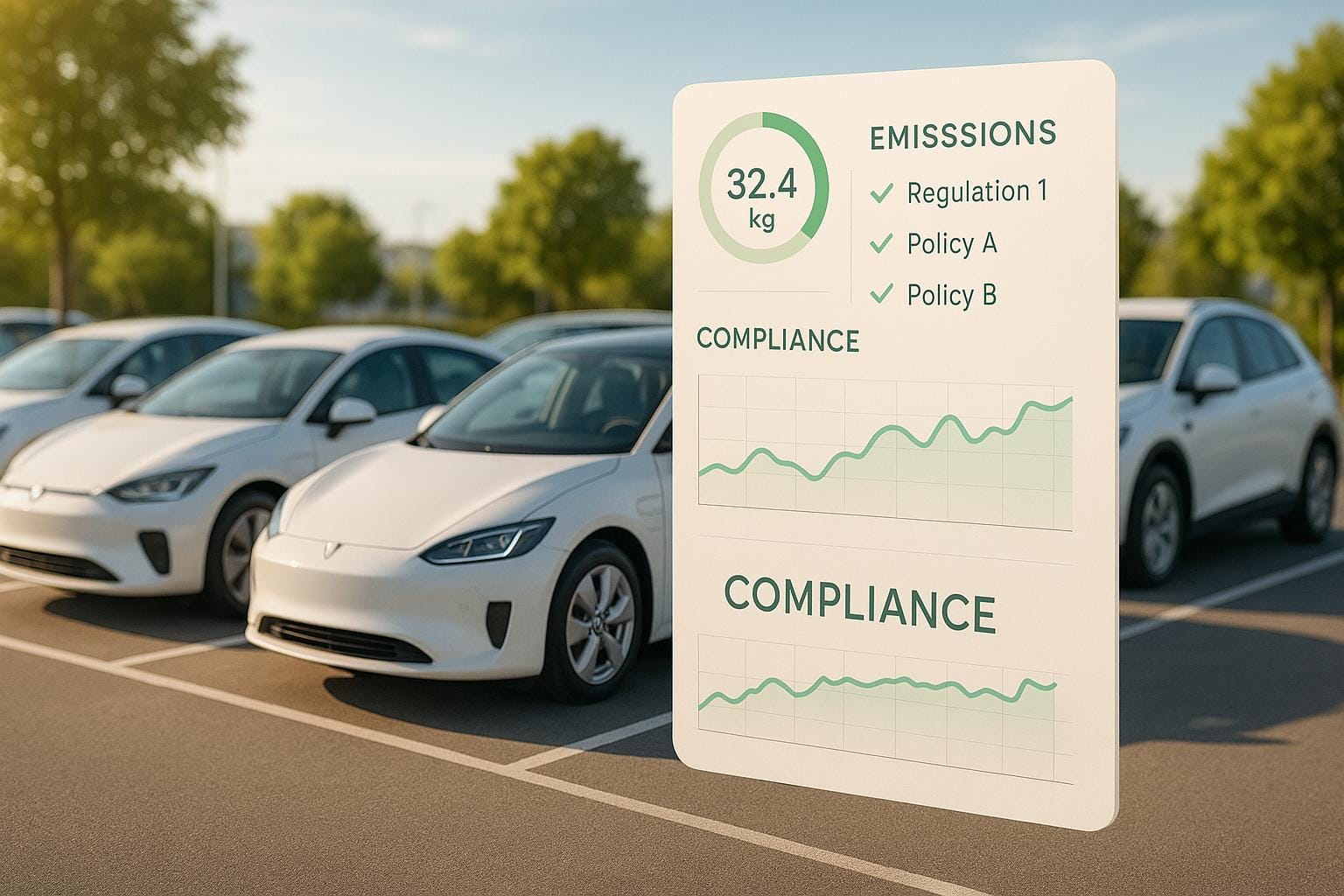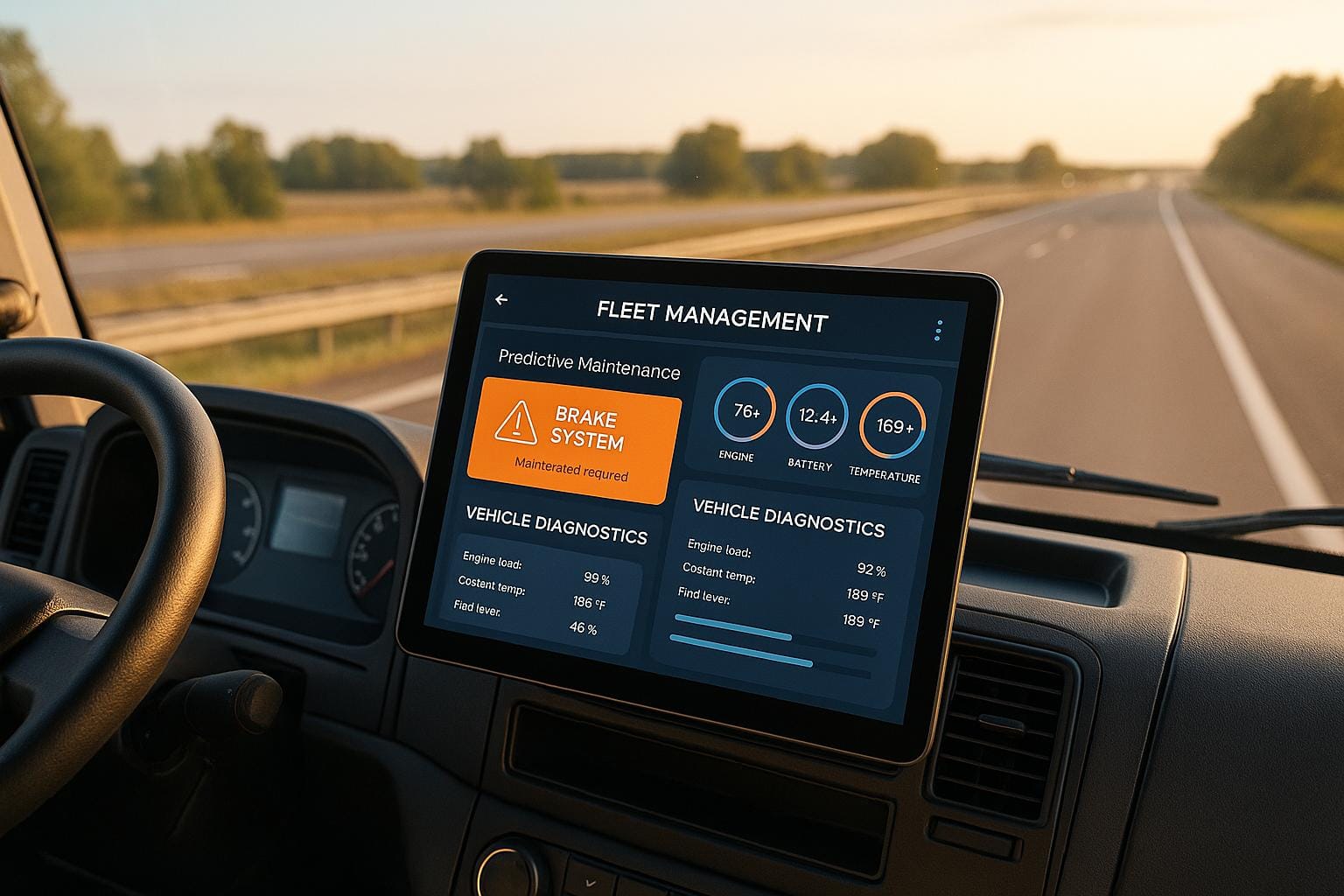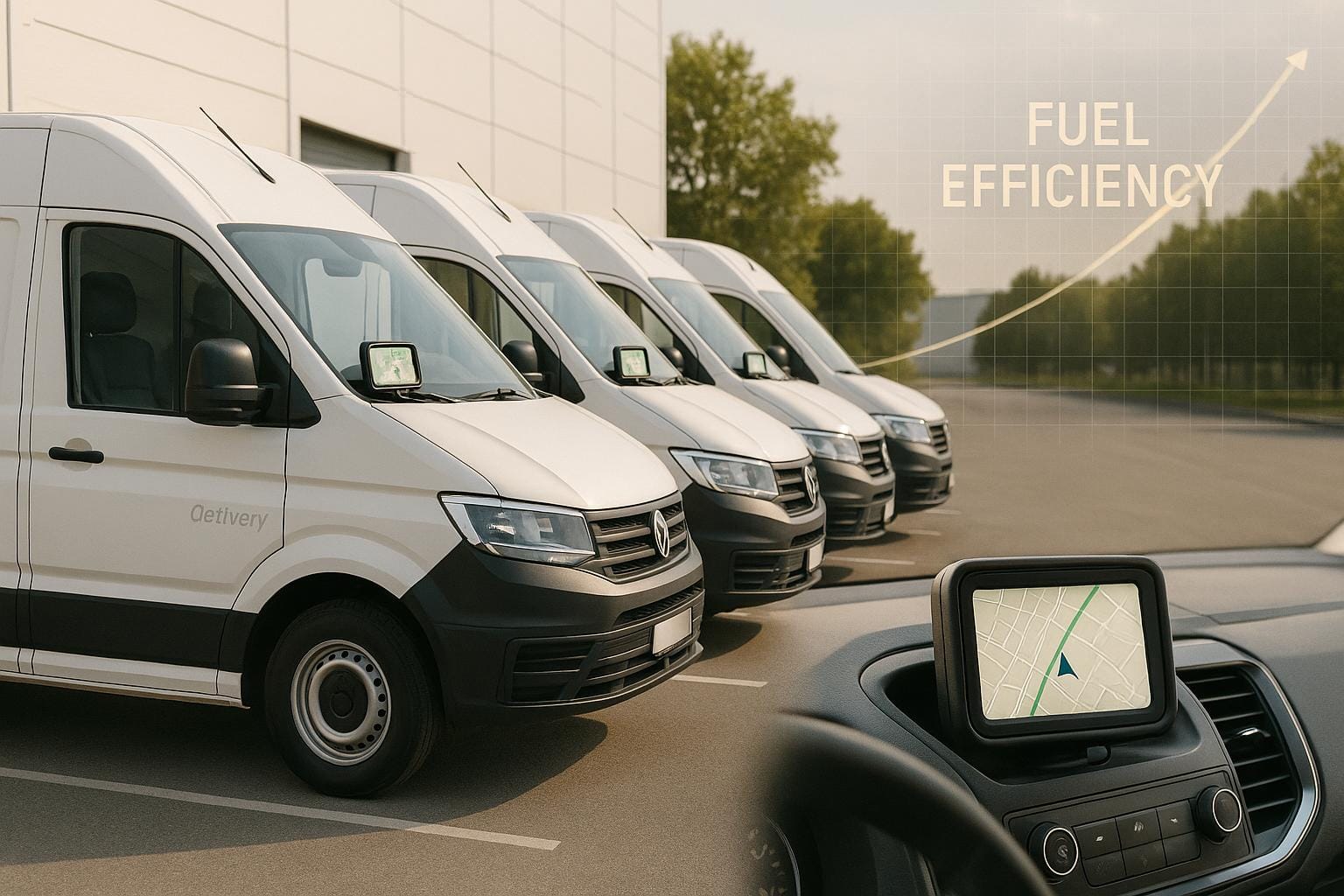Managing electric vehicle (EV) fleets in the UK is challenging, especially with strict regulations like the Zero Emission Vehicle (ZEV) Mandate and ULEZ requirements. Non-compliance can result in fines as high as £18,000 per van or £15,000 per car. Here's how telematics helps:
- Automated Compliance: Tracks emissions, driver behaviour, and vehicle performance to meet UK laws.
- Cost Savings: Reduces fuel costs by 22%, accident-related expenses by 20%, and maintenance costs by 14%.
- Simplified Reporting: Handles emissions and sustainability reporting, including Scope 1 and 2 emissions.
- Geofencing & Safety: Avoids fines in restricted zones and supports predictive maintenance to prevent breakdowns.
With telematics, staying compliant is easier, while improving efficiency and cutting costs.
| Compliance Area | Penalty Type | Amount |
|---|---|---|
| ZEV Mandate (Cars) | Per vehicle fine | £15,000 |
| ZEV Mandate (Vans 2025) | Per vehicle fine | £18,000 |
| London LEZ | Daily charge | Up to £300 |
| London ULEZ | Daily charge | £12.50 |
| Public Charge Point Issues | Per charge point fine | £500 |
Telematics is not just about compliance - it’s a tool for smarter, more efficient fleet management.
Fleet Electrification Process and how Telematics and our EVSA can help
UK EV Fleet Compliance Requirements
Navigating the UK's regulatory framework for electric vehicle (EV) fleets is no small task. Fleet operators face a host of obligations, and staying compliant is critical to avoiding hefty fines and keeping operations running smoothly. Let’s explore the key regulations and reporting standards shaping the EV landscape, as well as the risks of falling short.
Key Regulations for EV Fleets
The Zero Emission Vehicle (ZEV) Mandate is a cornerstone of the UK's push towards greener transport. By 2030, manufacturers must ensure that 80% of new cars and 70% of new vans are zero-emission, ramping up to 100% by 2035. For fleet operators, this means a decisive shift away from traditional fuel-powered vehicles is not just advisable - it’s unavoidable.
London’s Ultra Low Emission Zone (ULEZ) adds another layer of complexity. Expanded on 29 August 2023 to include all London boroughs, the ULEZ now impacts nearly 97% of vehicles driving in the city daily. Non-compliant vehicles have dropped by 58% since June 2023, reflecting the growing pressure on operators to meet emission standards.
Beyond these headline regulations, local emissions rules and specific MOT standards for EVs demand close attention. These standards differ from those for conventional vehicles, making regular compliance checks essential. This is where telematics systems can make a real difference, offering tools to monitor and manage compliance effectively.
Battery and Emissions Reporting Standards
With transport contributing to 25% of the UK’s total greenhouse gas emissions in 2021, fleet compliance plays a vital role in achieving national environmental goals. New reporting obligations are now ramping up the pressure on operators.
The UK Sustainability Disclosure Standards (UK SRS) are set to become mandatory for large businesses by Q3 2025. These standards require detailed reporting of Scope 1 and 2 emissions, shifting from voluntary disclosures to legally binding requirements.
Additionally, the UK Emissions Trading Scheme has tightened its grip, with allowances dropping from 81 million in 2022 to 69 million in 2024. For fleet operators, this means tracking emissions data and maintaining comprehensive fleet visibility is no longer optional. Tools like CO₂ and ESG-ready reporting and proactive risk monitoring are becoming essential as companies face growing scrutiny over environmental, social, and governance (ESG) metrics.
Failure to meet these standards doesn’t just risk fines - it could jeopardise procurement opportunities, as ESG compliance increasingly influences business relationships.
Risks of Non-Compliance
Non-compliance with the ZEV mandate can be costly for manufacturers, with fines of £15,000 per internal combustion engine car sold over the quota and £9,000 per van. By 2025, van penalties will rise to £18,000 per vehicle.
For fleet operators, the financial stakes are just as high. In London, non-compliant vehicles face daily charges of up to £300 in the Low Emission Zone, plus another £12.50 for entering the ULEZ. For larger fleets, these costs can quickly spiral into significant annual expenses.
| Compliance Area | Penalty Type | Amount |
|---|---|---|
| ZEV Mandate (Cars) | Per vehicle fine | £15,000 |
| ZEV Mandate (Vans 2024) | Per vehicle fine | £9,000 |
| ZEV Mandate (Vans 2025) | Per vehicle fine | £18,000 |
| London LEZ | Daily charge | Up to £300 |
| London ULEZ | Daily charge | £12.50 |
The Public Charge Point Regulations 2023 also introduce penalties of up to £500 per charge point for issues like unclear pricing, lack of contactless payment options, reliability failures, or poor data sharing.
Failing to meet MOT standards can lead to even bigger problems, such as invalidated insurance or driving bans, potentially grounding entire fleets. And let’s not forget the reputational damage - falling short on compliance can tarnish a company’s image, especially as ESG criteria take centre stage in procurement decisions.
With UK businesses registering 64,000 more battery-electric vehicles in 2024 than the previous year, the rapid pace of EV adoption is clear. As regulations evolve, the need for robust compliance management grows - and telematics solutions offer a lifeline, enabling automated monitoring and real-time tracking to help operators stay ahead.
How Telematics Makes Compliance Easier
With increasingly complex regulations, telematics technology provides a practical way to simplify compliance management for EV fleets. By automating processes like monitoring and reporting, it takes much of the burden off fleet operators.
Automated Data Collection and Reporting
Accurate data collection is the backbone of effective compliance management. Telematics systems gather key vehicle data, ensuring fleets meet UK standards while making compliance reporting more efficient. For EV fleets, this means critical performance metrics are always accessible. A survey by Fleetnews.co.uk revealed that 41% of fleet managers consider their environmental impact a top concern. Telematics not only delivers this data but also integrates with advanced tools such as geofencing and predictive maintenance to further enhance operations.
Geofencing and Route Planning
Geofencing redefines how EV fleets manage restricted areas like emission zones. Using GPS technology, virtual boundaries alert operators when vehicles approach these zones, helping to prevent penalties. In the UK, this feature is particularly useful for navigating emission-restricted zones and locating nearby EV charging stations.
Beyond avoiding fines, geofencing enables real-time route adjustments, cutting unnecessary mileage. This not only reduces operational costs but also helps lower carbon emissions, offering both financial and environmental advantages.
Predictive Maintenance and Safety Compliance
Predictive maintenance is a game-changer for EV fleet compliance. By leveraging real-time data, it ensures vehicles remain safe and operational while minimising unexpected breakdowns. This is especially crucial for EVs, which require specialised maintenance, such as monitoring battery health, brake performance, and tyre wear. For example, one logistics fleet using predictive maintenance identified potential battery and brake issues in several vehicles, allowing the manager to address these problems proactively and avoid unplanned downtime.
Setting Up Telematics for EV Fleet Compliance in the UK
Getting telematics right for your EV fleet in the UK means selecting the right technology and ensuring it aligns with local regulations. Let’s explore how to choose, configure, and deploy these systems effectively to meet compliance standards.
Choosing the Right Telematics Solution
Picking the right telematics system is key to managing compliance efficiently. The system must cater to the specific needs of electric vehicles while adhering to UK regulations.
Some must-have features include emissions monitoring, driver behaviour tracking, and tools to support your fleet's energy transition plans. The system should also track battery levels, charging station availability, and energy consumption. Look for solutions that offer carbon emission tracking, detailed energy usage reports, and a log of charging activities.
A good telematics system will also account for energy gained from sources like regenerative braking, ensuring precise energy reporting. It should be flexible to grow with your fleet's needs and offer reliable support and integration options.
Data protection is another critical factor. In the UK, GDPR and vehicle tracking laws must be followed when using GPS and telematics systems. Choose a provider that includes privacy features, such as switches to limit data collection to work-related trips for vehicles used personally as well.
Automation is a big advantage. Your system should automatically log mileage, track drivers' hours, and provide real-time updates, eliminating manual errors while ensuring consistent monitoring.
Setting Up Telematics for Compliance
Proper configuration is what unlocks the full potential of your telematics system. Both technical and operational details need attention during setup.
Start by focusing on data collection. Ensure the system gathers only the information necessary for compliance. This process must be lawful, transparent, and include clear communication with employees, along with their explicit consent.
Key metrics should drive your compliance monitoring. Configure automated alerts for maintenance needs, speed violations, and breaches of service hours. Geofencing can help manage emission-restricted zones and charging station locations. The system should also flag diagnostic issues like low oil or engine warnings to keep your vehicles compliant.
Telematics data is also valuable for driver training. Use it to promote safer driving habits, reducing accidents and improving overall fleet safety. Additionally, set up the system to detect fuel misuse, such as fuel card usage when the vehicle isn't present or fuelling beyond the tank's capacity.
Automated reporting is another essential feature. Configure your system to generate regular reports on compliance metrics and track charging events to ensure EVs are recharged at the best times and locations.
Using GRS Fleet Telematics Solutions

GRS Fleet Telematics offers a tailored solution designed for UK EV fleet compliance, combining hardware and software to meet diverse needs at competitive prices.
Their hardware options are designed to suit various security and compliance requirements:
- Essential (£35): A single wired tracker for cost-effective, real-time monitoring.
- Enhanced (£79): Includes a primary tracker and a secondary Bluetooth backup for added theft protection.
- Ultimate (£99): Adds immobilisation features for maximum security.
On the software side, GRS provides a comprehensive compliance monitoring package for £7.99 per vehicle per month. This includes SIM/data, a dedicated account manager, and full platform access, with no upfront recovery fees under a pay-per-recovery model.
Dual-tracker technology strengthens both security and compliance monitoring. Even if one tracker fails, the other ensures uninterrupted data collection. This setup supports a 91% recovery rate for stolen vehicles while maintaining consistent compliance records.
GRS also offers free installation when paired with fleet branding services, simplifying the process and reducing costs. The system includes real-time tracking, driver safety monitoring (such as speed and geofencing alerts), and eco-driving analytics. These tools help fleets meet environmental standards while reducing costs and administrative burdens.
To ensure smooth deployment, GRS provides 24/7 recovery support and white-label branding options for businesses needing custom solutions. Their scalable offerings can accommodate operations ranging from small businesses to large enterprise fleets.
Staying compliant requires regular monitoring and acting on telematics insights. With GRS Fleet Telematics, you’ll have the tools and support to maintain compliance, improve fleet performance, and cut operational costs.
Conclusion: Benefits of Telematics for EV Fleet Compliance
Telematics offers a powerful way to simplify EV fleet compliance while delivering measurable benefits across various aspects of business operations.
One standout advantage is cost savings. Take the example of a London-based courier company that managed to save £75,000 annually in 2023 by using telematics to enhance fuel efficiency. For EV fleets, these savings go beyond just fuel. They include optimised charging schedules and lower energy costs, making operations more economical.
Another key benefit is operational efficiency. Automated data collection and real-time monitoring play a big role here. For instance, Transport for London cut journey times by 15% across their fleet in 2023 after adopting telematics. By analysing traffic patterns, road conditions, and driver behaviour, telematics identifies inefficiencies and offers actionable solutions. Furthermore, predictive maintenance ensures vehicles stay on the road and meet safety standards, reducing the chance of costly breakdowns or compliance breaches.
Telematics also brings risk reduction into the picture. Continuous monitoring and automated alerts mean fewer surprises. According to Fleet News, UK companies using telematics for maintenance management in 2023 saw a 30% drop in unplanned repairs. This proactive approach not only prevents violations but also shields businesses from regulatory penalties while easing administrative headaches.
Speaking of administration, telematics significantly cuts down the administrative burden. It automates the tracking of driver hours, maintenance logs, and inspection records, reducing the chance of human error and simplifying compliance documentation.
Lastly, telematics enables data-driven strategic planning. With detailed insights into energy usage, charging habits, and fleet performance, businesses can make smarter, more informed decisions.
For fleet operators in the UK, telematics is more than just about ticking compliance boxes. It’s a comprehensive tool that reduces costs, enhances safety, and sets the stage for sustainable growth in the ever-evolving transport industry.
FAQs
How can telematics reduce the costs of managing an EV fleet while ensuring compliance with UK regulations?
How Telematics Supports EV Fleet Management in the UK
Telematics is a game-changer for businesses managing electric vehicle (EV) fleets, offering tools to improve efficiency, cut costs, and stay compliant with UK regulations. By delivering real-time insights into vehicle performance and usage, telematics helps fleet managers make smarter decisions. For example, it can help optimise routes, reduce energy consumption, and ensure vehicles are being used effectively. The result? Lower operational costs and better alignment with emissions and maintenance standards.
Another major benefit is proactive maintenance. Telematics systems can flag potential issues early, minimising the risk of unexpected breakdowns and costly repairs. They also track driver behaviour, encouraging safer driving habits that can lead to reduced insurance premiums. By combining these features, telematics simplifies compliance and delivers tangible cost savings for businesses running EV fleets in the UK.
How does geofencing in telematics help manage EV fleets in low-emission zones?
Geofencing Technology in Telematics for EV Fleets
Geofencing technology is proving to be a game-changer for managing electric vehicle (EV) fleets, especially in low-emission zones. By enabling real-time vehicle tracking, it ensures that fleets adhere to local environmental regulations. Fleet managers receive automated alerts when vehicles enter or leave restricted areas, which helps streamline operations and avoid costly penalties.
Another key benefit is route optimisation. Geofencing can reroute vehicles to bypass emission-restricted zones when needed, saving time and improving overall efficiency. On top of that, it simplifies data collection for emissions reporting, making it easier for businesses to stay compliant with regulations.
Beyond compliance, geofencing boosts safety by preventing unauthorised vehicle use in sensitive or restricted areas. This technology not only makes fleet management more efficient but also offers peace of mind by enhancing operational control and accountability.
How do telematics systems help EV fleets comply with UK sustainability and emissions reporting standards?
Telematics systems play a crucial role in helping electric vehicle (EV) fleets meet the UK's stringent sustainability and emissions reporting standards. By delivering real-time data on key metrics like energy usage, mileage, and CO2 emissions, these systems make it much easier to generate the precise reports needed to comply with regulations such as the Corporate Sustainability Reporting Directive (CSRD).
Beyond ensuring compliance, telematics offers fleet managers valuable insights to boost efficiency and cut emissions. This dual benefit not only supports environmental targets but also improves day-to-day operations, helping businesses align seamlessly with the UK's green objectives.




